The Heart Block Therapeutics Market is estimated to be valued at USD 3.5 billion in 2025 and is projected to reach USD 5.4 billion by 2035, registering a compound annual growth rate (CAGR) of 4.3% over the forecast period.
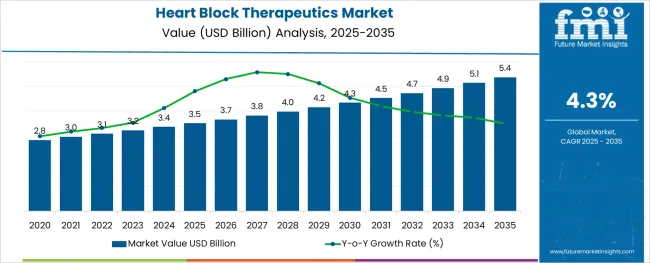
The heart block therapeutics market is advancing steadily, supported by the rising prevalence of cardiac conduction disorders and growing awareness of effective treatment options. Clinical studies have underscored the significant impact of heart blocks on cardiac function and patient quality of life, prompting increased diagnosis and intervention efforts.
Technological innovations in cardiac devices have improved therapeutic outcomes and patient safety. Healthcare providers are placing greater emphasis on early detection through hospital testing and monitoring, which has led to timely treatment initiation.
Regulatory frameworks and reimbursement policies have also facilitated wider access to advanced therapeutics. Looking ahead, market growth is expected to be driven by advancements in device miniaturization, enhanced battery life, and expanding applications in remote patient monitoring. Segmental growth is anticipated to be led by treatment of Third Degree Heart Blocks, pacemaker product types, and hospital testing as the primary end-use setting.
The market is segmented by Type, Product, and End User and region. By Type, the market is divided into Third to degree heart blocks, First to degree heart blocks, and Second to degree heart blocks. In terms of Product, the market is classified into Pacemaker, Transcutaneous pacing (TCP), Mediation, and Follow to up electrophysiology study. Based on End User, the market is segmented into Hospital testing, Home treatment, Clinics, and Others. Regionally, the market is classified into North America, Latin America, Western Europe, Eastern Europe, Balkan & Baltic Countries, Russia & Belarus, Central Asia, East Asia, South Asia & Pacific, and the Middle East & Africa.
The market is segmented by Type, Product, and End User and region. By Type, the market is divided into Third to degree heart blocks, First to degree heart blocks, and Second to degree heart blocks. In terms of Product, the market is classified into Pacemaker, Transcutaneous pacing (TCP), Mediation, and Follow to up electrophysiology study. Based on End User, the market is segmented into Hospital testing, Home treatment, Clinics, and Others. Regionally, the market is classified into North America, Latin America, Western Europe, Eastern Europe, Balkan & Baltic Countries, Russia & Belarus, Central Asia, East Asia, South Asia & Pacific, and the Middle East & Africa.
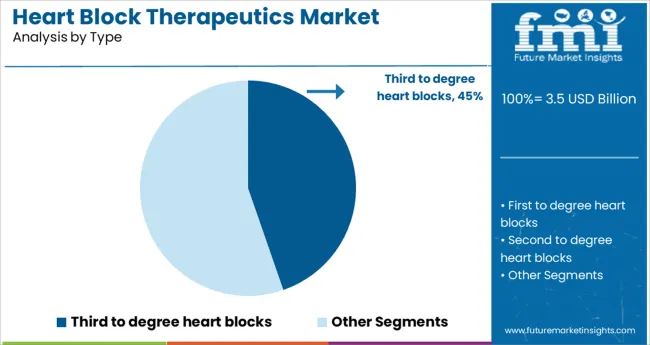
The Third Degree Heart Blocks segment is projected to hold 44.7% of the heart block therapeutics market revenue in 2025, maintaining its position as the leading type segment. This segment’s growth is fueled by the severity and life-threatening nature of complete heart block, which necessitates prompt and effective therapeutic intervention.
Clinical protocols strongly recommend device implantation to restore proper cardiac rhythm in affected patients. The segment benefits from increasing diagnosis rates due to enhanced cardiac monitoring and electrophysiological studies.
Additionally, the high risk of complications and mortality associated with untreated third degree blocks underscores the importance of this segment. With continuous innovation in device technology and increased screening efforts, the Third Degree Heart Blocks segment is expected to remain the dominant focus in heart block therapy.
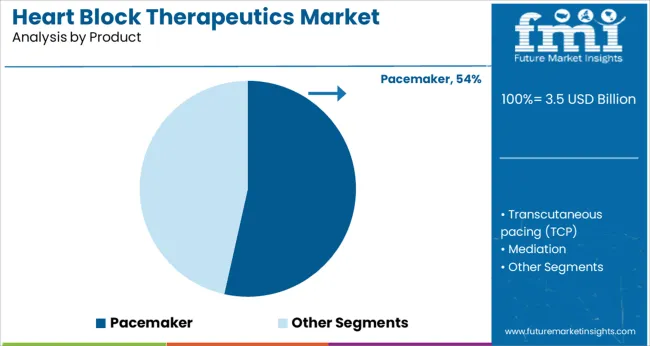
The Pacemaker segment is projected to contribute 53.5% of the heart block therapeutics market revenue in 2025, establishing it as the most widely used product type. Pacemakers are preferred due to their proven efficacy in managing various degrees of heart block by maintaining an adequate heart rate and rhythm.
Advances in pacemaker design have led to smaller, more efficient, and longer-lasting devices that enhance patient comfort and compliance. The increasing adoption of implantable cardiac devices in clinical practice has also expanded market penetration.
Moreover, the development of leadless pacemakers and devices with remote monitoring capabilities is expected to boost growth further. As pacemakers remain the standard of care for heart block treatment, this segment is projected to sustain its market leadership.

The Hospital Testing segment is projected to hold 59.2% of the heart block therapeutics market revenue in 2025, reinforcing its role as the primary end-use environment. Hospitals are equipped with specialized diagnostic tools such as electrocardiograms and electrophysiology labs essential for accurate heart block detection and monitoring.
The availability of multidisciplinary cardiac care teams facilitates timely therapeutic decisions and device implantation procedures. Furthermore, hospitals provide comprehensive post-implantation follow-up and device programming services.
Growing investments in cardiac care infrastructure and increasing patient admissions for cardiac conditions are driving demand within this segment. With continued emphasis on early diagnosis and integrated cardiac care, the Hospital Testing segment is expected to maintain its leadership in the heart block therapeutics market.
North America leads the demand for Heart Block Therapeutics in terms of having the largest market for the Heart Block Therapeutics Market due to the increasing cases of cardiovascular diseases in the region. Around 805 thousand people in the USA have heart attacks every year. The USA spends more than USD 320 Billion annually which is 15% of their total healthcare spending to manage and treat cardiovascular diseases and cardiovascular risk factors.
Recently, the USA Food and Drug Administration announced the approval of Farxiga (dapagliflozin) oral tablets for adults with heart failure with reduced ejection fraction to reduce the risk of cardiovascular death and hospitalization for heart failure. Farxiga in a clinical trial showed to improve survival of heart attack patients and reduce the need for hospitalization in adults with heart failure with reduced ejection fraction.
Asia Pacific is the most optimistic market for Heart Block Treatment due to massive population with high unmet medical needs. Around 58% of the total number of heart attack deaths occur in Asia Pacific alone.
China and India have the most promising market for Heart Block Therapeutics. Besides, there have also been significant investments from the government to several large companies in the recent years.
The PEACE MPP is a government-funded public health programme which focuses on cardiovascular disease risk in China. Health Technology firm Abbott has two training centres in China to better serve the Chinese Cardiovascular Patients. Abbott has also made investments into clinical research that will help Chinese doctors complete their projects in the cardiovascular research.
The Indian healthcare system has been using advanced technology and artificial intelligence to perform heart treatments. For instance, in India Medtronic launched the Arctic Front Cardiac Cryoablation Catheter System, a cryoballoon catheter approved by the Central Drugs Standard Control Organisation (CDSCO) for the treatment of atrial fibrillation (AF) in India.
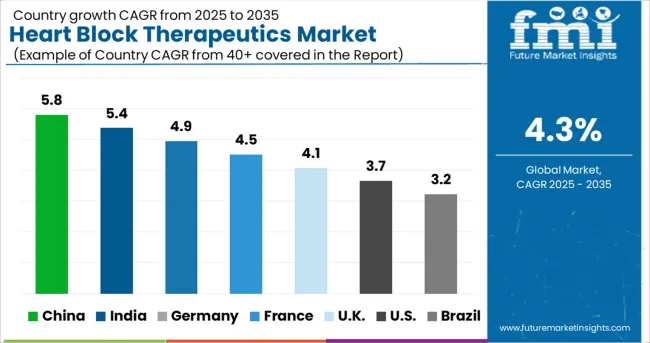
The United States has the largest market for Heart Block Therapeutics, which is projected to reach a valuation of USD 5.4 Billion by 2035. From 2020 to 2024, the market in the USA grew at a CAGR of 4.7%. Between 2025 and 2035, the USA is expected to be a market with a USD 570.5 Million absolute dollar opportunity for heart block treatment.
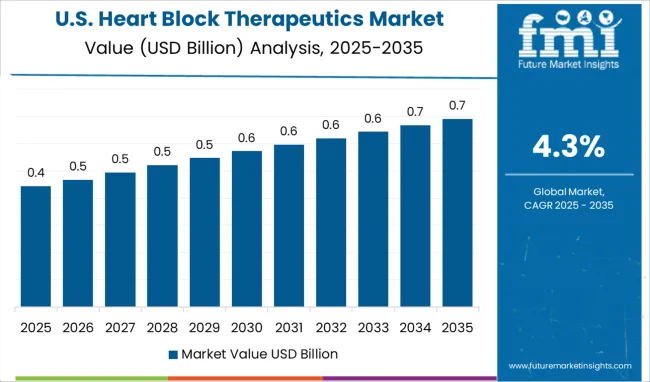
In 2020, The American Heart Association invested USD 2.8 Billion for advanced research in Heart Block Therapeutics. The United States Centres with WHO launched the Global Hearts Initiative in September 2020, which includes the Heart technical package.
The package has six modules including healthy-lifestyle counselling, evidence-based treatment protocols, access to essential medicines and technology, risk-based management, team-based care, and systems for monitoring. It provides a strategic approach to improve cardiovascular health in USA. as well as other countries across the world.
In 2024, China was the second-largest Heart Block Therapeutics Market after the USA. The market in the country is expected to reach a valuation of USD 344 Million by 2035. In China, coronary bypass surgery, ONCAB, OPCAB, and heart valve replacement devices are all frequently used, resulting in significant growth in the cardiology market.
Heart disease-causing variables such as hypertension, diabetes, excessive alcohol use, cholesterol, and smoking are all on the rise in the region. Guidewires, catheters, radial closure devices, micro guidewires, and stent delivery catheters are among the most extensively used cardiology products in China. The country can additionally explore the Heart Block Therapeutics industry due to favourable government rules and policies.
Growing incidence and prevalence rate of hypertension, high cholesterol, diabetes, smoking, obesity, unhealthy dietary plans and older population across the world, government initiatives to increase the awareness toward heart related diseases are the key driving factors in Heart Block Therapeutics Market.
Although one out of every five First Degree Heart blocks require serious medical help, treatment for First Degree Heart Blocks were the most demanded with a CAGR of 5% during 2020-2024. The market through this category is expected to remain the treatment service that will generate the most revenue for the market in the upcoming years with an expected CAGR of 4.4% by the end of 202.82.
The development of pacemakers and minimally invasive vessel treatment together are enhancing the growth of the market. Pacemakers are usually used in the treatment of second degree heart blocks and third degree heart blocks.
Globally, there are about 2.8 Million people using pacemakers, and every year around 600 thousand pacemakers are implanted. Market revenue through pacemakers has witnessed a CAGR growth of 4.8% from 2020 to 2024, and the projected CAGR through this category is expected to be 4.2% by 202.82.

At present, the Heart Block Therapeutics market is moderately competitive and has numerous players. There are only a few key players which dominate the market and have a much wider geographic presence and improved research and development resources ensuing in robust regulatory approvals.
The key companies operating in the Heart Block Therapeutics Market are St. Jude Medical, Medtronic, Bristol Myers Squibb, Novartis AG, Boston Scientific Corporation, SORIN S.p.A, BIOTRONIK SE & Co. KG, Edward Lifesciences Corporation, Abbott Laboratories, Natco Pharma, Pfizer Inc., Bayer AG, Janssen Pharmaceuticals, Inc., Astra Zeneca, Sanofi, Merck & Co., Inc., Gilead Sciences, Inc., F. Hoffmann-La Roche Ltd.
Some of the recent developments by the key providers of Heart Block Therapeutics are as follows:
| Attributes | Details |
|---|---|
| Forecast Period | 2025 to 2035 |
| Historical Data Available for | 2020 to 2024 |
| Market Analysis | million for Value |
| Key Countries Covered | United States, Canada, Brazil, Mexico, Germany, UK, France, Spain, Italy, Russia, China, Japan, South Korea, India, Australia, South Africa, Saudi Arabia, UAE and Israel |
| Key Market Segments Covered | Type, Product, End User, Region |
| Key Companies Profiled | Koninklijke Philips N.V.; Bristol Myers Squibb; Edward Lifesciences Corporation; St. Jude Medical; Medtronic; Natco Pharma; Boston Scientific Corporation; SORIN S.p.A; BIOTRONIK SE & Co. KG; Abbott Laboratories; Novartis AG; Pfizer Inc.; Bayer AG; Janssen Pharmaceuticals, Inc.; AstraZeneca,; Sanofi, Merck & Co., Inc.; Gilead Sciences, Inc.; F. Hoffmann-La Roche Ltd |
| Report Coverage | Value (In billion) |
| Customization & Pricing | Available upon Request |
The global heart block therapeutics market is estimated to be valued at USD 3.5 billion in 2025.
It is projected to reach USD 5.4 billion by 2035.
The market is expected to grow at a 4.3% CAGR between 2025 and 2035.
The key product types are third to degree heart blocks, first to degree heart blocks and second to degree heart blocks.
pacemaker segment is expected to dominate with a 53.5% industry share in 2025.






Our Research Products

The "Full Research Suite" delivers actionable market intel, deep dives on markets or technologies, so clients act faster, cut risk, and unlock growth.

The Leaderboard benchmarks and ranks top vendors, classifying them as Established Leaders, Leading Challengers, or Disruptors & Challengers.

Locates where complements amplify value and substitutes erode it, forecasting net impact by horizon

We deliver granular, decision-grade intel: market sizing, 5-year forecasts, pricing, adoption, usage, revenue, and operational KPIs—plus competitor tracking, regulation, and value chains—across 60 countries broadly.

Spot the shifts before they hit your P&L. We track inflection points, adoption curves, pricing moves, and ecosystem plays to show where demand is heading, why it is changing, and what to do next across high-growth markets and disruptive tech

Real-time reads of user behavior. We track shifting priorities, perceptions of today’s and next-gen services, and provider experience, then pace how fast tech moves from trial to adoption, blending buyer, consumer, and channel inputs with social signals (#WhySwitch, #UX).

Partner with our analyst team to build a custom report designed around your business priorities. From analysing market trends to assessing competitors or crafting bespoke datasets, we tailor insights to your needs.
Supplier Intelligence
Discovery & Profiling
Capacity & Footprint
Performance & Risk
Compliance & Governance
Commercial Readiness
Who Supplies Whom
Scorecards & Shortlists
Playbooks & Docs
Category Intelligence
Definition & Scope
Demand & Use Cases
Cost Drivers
Market Structure
Supply Chain Map
Trade & Policy
Operating Norms
Deliverables
Buyer Intelligence
Account Basics
Spend & Scope
Procurement Model
Vendor Requirements
Terms & Policies
Entry Strategy
Pain Points & Triggers
Outputs
Pricing Analysis
Benchmarks
Trends
Should-Cost
Indexation
Landed Cost
Commercial Terms
Deliverables
Brand Analysis
Positioning & Value Prop
Share & Presence
Customer Evidence
Go-to-Market
Digital & Reputation
Compliance & Trust
KPIs & Gaps
Outputs
Full Research Suite comprises of:
Market outlook & trends analysis
Interviews & case studies
Strategic recommendations
Vendor profiles & capabilities analysis
5-year forecasts
8 regions and 60+ country-level data splits
Market segment data splits
12 months of continuous data updates
DELIVERED AS:
PDF EXCEL ONLINE
Heart Pump Device Market Forecast and Outlook 2025 to 2035
Blockchain Interoperability Market Size and Share Forecast Outlook 2025 to 2035
Blockchain Food Traceability Market Size and Share Forecast Outlook 2025 to 2035
Blockchain AI Market Size and Share Forecast Outlook 2025 to 2035
Heart Beat Sensor Market Size and Share Forecast Outlook 2025 to 2035
Block Sack Market Size and Share Forecast Outlook 2025 to 2035
APAC Heart Health Functional Food Market Size and Share Forecast Outlook 2025 to 2035
Blockchain Messaging Apps Market Size and Share Forecast Outlook 2025 to 2035
Blockchain in Logistics Market Size and Share Forecast Outlook 2025 to 2035
Heart Closure Devices Market Size and Share Forecast Outlook 2025 to 2035
Blockchain Market Size and Share Forecast Outlook 2025 to 2035
Blockchain in Energy Market Size and Share Forecast Outlook 2025 to 2035
Blockchain Identity Management Market Size and Share Forecast Outlook 2025 to 2035
Blockchain in Agriculture and Food Supply Chain Market Size and Share Forecast Outlook 2025 to 2035
Block Pallets Market Size and Share Forecast Outlook 2025 to 2035
Heart Beat Irregularity Detection Device Market Trends - Growth & Forecast 2025 to 2035
Blockchain Technology Market Analysis & Forecast 2025 to 2035, By Solution, Use Case, Enterprise Size, Industry, and Region
Market Share Breakdown of Block Pallets Industry
Blockchain in Banking Market
Heart Beat Monitor and Sensor Market

Thank you!
You will receive an email from our Business Development Manager. Please be sure to check your SPAM/JUNK folder too.
Chat With
MaRIA